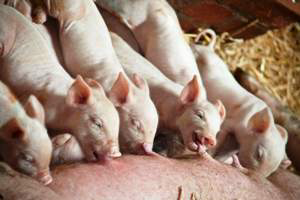Column: Breed differences

What the text books don’t tell you about: Do breed differences matter? The textbooks are mostly silent on this subject. Anyway, as I see it – the answer is both yes and no. Yes , because there have always been differences. Less now, but still there. And no, because it is the producer’s responsibility to match any differences to his own circumstances, as I will go on to explain.
First let me define ‘breed’ – now an old-fashioned term. Saddleback, Large White, Yorkshire, Landrace, Duroc and so on. Years ago I had sharp-end experience of farming many of them and learned not only how different they were, but also that often they had to be managed differently as well. Now all their different genes have been incorporated into a galaxy of various genetic traits going to make up hundreds of lines available commercially as semen or replacement gilts.
And the modern genetically-improved seedstock?
Do their differences matter too? Again yes and no. Yes because there are differences – in body shape, leg strengths, temperament, ability to cope with stressors, how the stock cope with very hot and especially wet climates where appetite is so important, and so on. Added to this are the firms supplying the genes: some are more helpful with regard to selection, supply and choice of multiplier, others in their tight selection pressure constraints. On the other hand most of the better breeding houses these days have put disease testing high on their priority list.
And yet to a certain extent no, because taking about eight of the 16 (?) or so well-known and commercial lines available today, they are all in my experience very good indeed and I am tempted to say choice doesn’t matter all that much now with the top-flight companies. Certainly much less than it used to. The improvement in genetic capability is way beyond what it was even 20 years ago, and these firms have done a great job for us.
But which to choose?
Because of these recognised advances I am often asked, “Which do you consider the best line today?” There isn’t one. The best line is the one which best suits your circumstances. That apparently facile reply is not a cop-out, but a dose of realism. Since 2000 my most contented clients have been those who have settled on a ‘breed’ or line which suits their market outlet, their facilities, capital availability and quality (and numbers) of staff. The care and efficiency of the supplier is also becoming more important as I am coming across more and more comments like, “They look after me well”, and “I trust them.” Quite a bit of this customer care depends on a good and experienced local fieldsman who keeps an eye on supply with the ‘upstairs’ people.
Filling the performance gaps
Having said this, much of the success comes with the producer being honest with himself. Now there’s a strange thing to say! It comes from appreciating that every pig farm is different. And that the differences occur not only between farms but within the unit over time. The right genetics for any farm depends on those which are most likely to fill in the current performance gaps. Every unit has them – it may be food conversion, daily gain, grading, evenness, temperament, legs – and certain lines are demonstrably good at one or several of them. Others less so.
Being honest with yourself
There are two sets of questions which need to be asked.
Firstly, the producer must be honest with him- or herself so as to recognise, accept and know which of his/her performance limitations need improvement. The main source is some basic records and I am amazed how few producers now have them – or sufficient of the right ones. Time and short-staffing (‘tail-chasing’ is a records-killer) and maybe the complexity of modern computerised records is putting put people off? So keep it simple and basic essentials only – you extremely clever computer guys, many of whom I’ve talked to at expos have never worked on a pig farm and whose intelligent noses seem to be too close to the binary trees.
The second set of questions are for the seedstock firm. “Here is what seem to be my weaknesses. Which of your lines are most likely to fill those gaps? I seem to be quite strong here – and here – so perhaps we can ease a bit on them? What do you think?”
I have had two such discussions with one supplier and was impressed that the data could be entered into his computer and both physical and economic possibilities emerged – how much ‘easing’ on one characteristic might cost and whether the input into the weak sector could override it and by how much. The ‘what if factor’ now being used in nutrition being applied to genetics.
But without those records – a no-brainer!
Source: Pig Progress magazine, 30.5 (2014)











